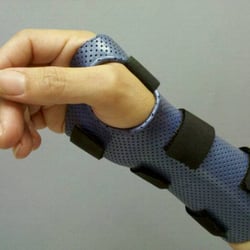|
BOOK NOW |
ASK ABOUT YOUR PAIN |
Home > Blog > Hand Therapy & Customized Splinting > Conditions > Finger, Hand, Wrist, Forearm & Elbow Conditions > Wrist Tendinitis Hand Therapy
Wrist Tendinitis Hand Therapy

Wrist tendinitis is a condition that most typically happens to individuals who perform repetitive activities using the hand and arm.
These include
- computer users
- factory workers
- and athletes who throw and catch balls and play racquet sports
In the United States, the incidence of tendinitis as an occupational injury in people who work full time is 1.1 per 100,000. In fact, overuse tendinitis is responsible for 25% to 50% of all sports injuries in the United States.
Typically, it's older individuals who are often more at risk for wrist tendinitis due to a loss of elasticity in the wrist tendons.
Our senior hand therapists and senior physiotherapists help people with wrist tendinitis to
- reduce their pain
- increase their wrist flexibility and strength
- and return to their previous functional activities and sports
first of all, What is Wrist Tendinitis?
Wrist tendinitis refers to a painful wrist condition where 1 or more tendons in the wrist become inflamed and irritated.
There are several tendons in the wrist that connect the muscles of the forearm and hand to the bones of the wrist and hand. These tendons are the small rope-like structures that you can see connecting to the fingers on the back of your hand.
There are a number of conditions that can affect the tendons in this area.
- Wrist tendinitis applies to the early stages of tendon inflammation and irritation.
- Tendinopathy is the name given to the condition when it persists over time, is not treated, and becomes chronic.
- Tenosynovitis is the term given to an irritation that develops when the synovial sheath (through which some of these tendons glide) thickens and restricts the tendon.
- De Quervain's Tendinitis applies to tendinitis that develops on the thumb side of the wrist.
How Does wrist tendinitis Feel like?
Several tendons in the wrist can become irritated with wrist tendinitis. Pain symptoms associated with the condition include:
- Pain where the arm meets the hand, which can radiate up into the elbow.
- Pain on the thumb side of the wrist (radial) or the little-finger side of the wrist (ulnar).
- Pain that only occurs when the wrist is under strain, which can become constant pain when left untreated.
- Pain when putting pressure on the hand, such as using the arms to push yourself up out of a chair to stand.
Besides pain, other symptoms include:
- Stiffness of the wrist, and a decreased ability to bend and extend the wrist.
- Inflammation or swelling in the wrist area.
- Tenderness to touch in the wrist and/or forearm muscles.
How Is It Diagnosed?
Our senior hand therapists and senior physiotherapists will conduct a thorough evaluation of your entire arm to include the shoulder, elbow, wrist, and hand.
We will ask you to describe the types of activities you normally perform using your arm at home, at work, and for recreation, and which of these activities causes pain or stiffness in the area. You will be asked how long the pain has been occurring and how it is affecting your regular activities of daily living.
We also will check your range of motion and strength in your entire upper arm. We will gently touch specific areas of your wrist and forearm to determine which wrist tendons are involved, and check for any swelling in the area.
How Can Our senior hand therapists and senior physiotherapists Help?

Hand therapy and physiotherapy is a highly effective treatment for wrist tendinitis.
You will work with Our senior hand therapists and senior physiotherapists to devise a treatment plan that is specific to your condition and goals.
Your individual hand physiotherapy treatment program may include:
Pain Management
We will help you identify and avoid painful movements, and show you how to correct abnormal postures to reduce stress on the wrist.
We may recommend resting the wrist short-term, and applying cold therapy to the area to help alleviate pain. We also may apply a customized wrist brace to restrict wrist movement, allowing the tendons to heal.
Other pain relief modalities we may use includes
Manual Therapy
We may use manual therapy techniques, such as
- gentle joint movements
- soft-tissue massage
- stretching exercises
- wrist stretches
to get your wrist moving properly.
Range-of-Motion Exercises
You will learn exercises and stretches to reduce stiffness and help your wrist, hand, and forearm begin to move properly.

Strengthening Exercises
We will determine which strengthening exercises are right for you, depending on your specific areas of weakness. The entire arm, including the shoulder, elbow, and wrist, can potentially be weakened and contribute to the movement dysfunction that causes tendinitis.
We will design an individualized home-exercise program to meet your specific needs and goals, which you can continue long after you have completed your formal hand and physical therapy.
Patient Education
Depending on the specific activities you plan on resuming, we will teach you ways to perform actions, while protecting your wrist and hand.
For example, keeping the wrist in a neutral position to reduce excessive force while performing repetitive tasks, and taking frequent breaks are ways to decrease your chances of reinjury.
Functional Training
As your symptoms improve, we will teach you how to correctly perform functional movement patterns using proper wrist mechanics, such as typing on a computer or swinging a racquet.
This training will help you return to pain-free function on the job, at home, and when playing sports.